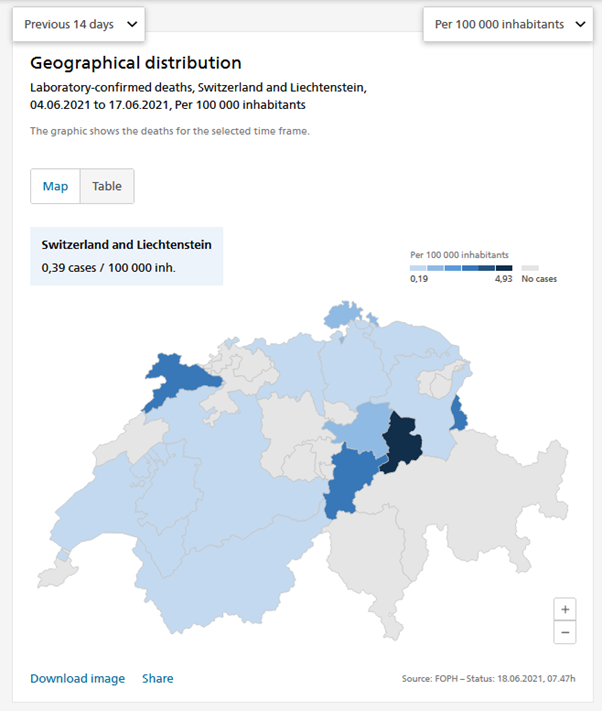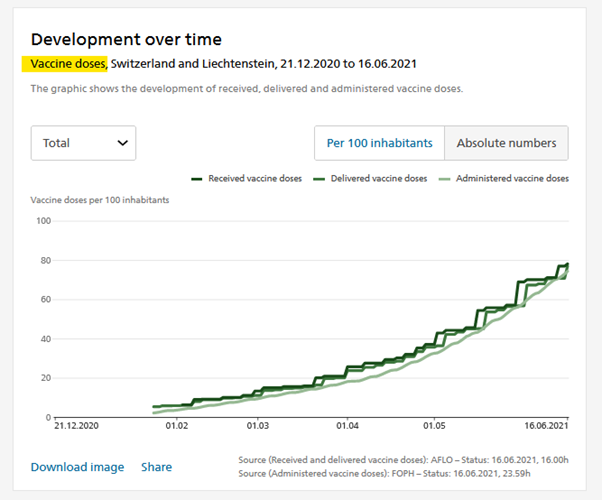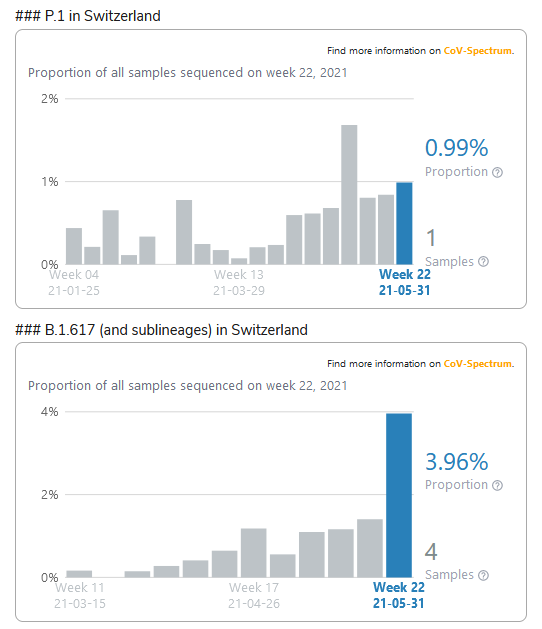
COVID-19 IN SWITZERLAND. Week to 19.06.2021—continuing ⬇️
Next easing Jun 28?
Per 100K pop, total & last 2 weeks
● cases—8116 & 47 (⬇️)
● in hospital—336 & 2 (—)
● deaths—119 & 0.4 (—)
R(e): ⬇️—0.59
Vaccinations: 6.4m (2.5m 2nd doses)
FOPH covid19.admin.ch/en/overview?ov…
1/11



Next easing Jun 28?
Per 100K pop, total & last 2 weeks
● cases—8116 & 47 (⬇️)
● in hospital—336 & 2 (—)
● deaths—119 & 0.4 (—)
R(e): ⬇️—0.59
Vaccinations: 6.4m (2.5m 2nd doses)
FOPH covid19.admin.ch/en/overview?ov…
1/11




AND FOR THE PAST FORTNIGHT, R(e) since Sep28
covid19.admin.ch/en/overview
The previous tweet shows that numbers are definitely coming down again after a short rebound in April-early May, although deaths stayed flat.
These are for the last fortnight, except R(e):
2/11



covid19.admin.ch/en/overview
The previous tweet shows that numbers are definitely coming down again after a short rebound in April-early May, although deaths stayed flat.
These are for the last fortnight, except R(e):
2/11




VIRUS VARIANTS detected
UK variant dominant. Delta (B.1.617) surging?
Public Health Office: covid19.admin.ch/en/epidemiolog…
Science Task Force: sciencetaskforce.ch/en/nextstrain-…
3/11



UK variant dominant. Delta (B.1.617) surging?
Public Health Office: covid19.admin.ch/en/epidemiolog…
Science Task Force: sciencetaskforce.ch/en/nextstrain-…
3/11




BY CANTON: LAB-CONFIRMED CASES in the past fortnight per 100K population—Overall down from 78 to 48. Similar pattern. Worst in Appenzell Innerrhoden. Dark end of range down from 403 to 242.
More: covid19.admin.ch/en/epidemiolog…
4/11
More: covid19.admin.ch/en/epidemiolog…
4/11

BY CANTON: LAB-CONFIRMED HOSPITALISATION in the past fortnight per 100K population—Improving, down from 2.19 to 1.56. Still worst in Obwalden, dark end of range stays at 11
More: covid19.admin.ch/en/epidemiolog…
5/11
More: covid19.admin.ch/en/epidemiolog…
5/11

BY CANTON: DEATHS (which lag case numbers)—down from 0.43 to 0.39. Worst in Glarus, Uri, Jura and Liechtenstein. Several cantons recording no deaths. Dark end of range stays at 4.93.
More: covid19.admin.ch/en/epidemiolog…
6/11
More: covid19.admin.ch/en/epidemiolog…
6/11

INTENSIVE CARE CAPACITY AND OCCUPANCY: all patients and COVID-19
Over 150 hospitals/clinics (Glarus, Appenzell Innerrhoden have no IC units)
All patients: improving
COVID-19 patients: improving
More: covid19.admin.ch/en/hosp-capaci…
7/11


Over 150 hospitals/clinics (Glarus, Appenzell Innerrhoden have no IC units)
All patients: improving
COVID-19 patients: improving
More: covid19.admin.ch/en/hosp-capaci…
7/11



R(e) ESTIMATES: national over time, cantons latest.
Down. All cantons <1. More < 0.8
Estimate: 0.59 nationally (from 0.67)
More: covid19.admin.ch/en/repro/val
Note: Swiss schools have stayed open during lockdown
8/11

Down. All cantons <1. More < 0.8
Estimate: 0.59 nationally (from 0.67)
More: covid19.admin.ch/en/repro/val
Note: Swiss schools have stayed open during lockdown
8/11


VACCINATIONS (1) VACCINES & DEMOGRAPHY
Moderna outstripping Pfizer/BioNTech
Ordered: 36m doses: Pfizer/BioNTech, Moderna, AstraZeneca, Curevac and Novavax (pop 8.6m)
Approved: Pfizer/BioNTech, Moderna, J&J (not ordered)
covid19.admin.ch/en/epidemiolog…
covid19.admin.ch/en/epidemiolog…
9/11



Moderna outstripping Pfizer/BioNTech
Ordered: 36m doses: Pfizer/BioNTech, Moderna, AstraZeneca, Curevac and Novavax (pop 8.6m)
Approved: Pfizer/BioNTech, Moderna, J&J (not ordered)
covid19.admin.ch/en/epidemiolog…
covid19.admin.ch/en/epidemiolog…
9/11




VACCINATIONS (2) OVERALL
Accelerating. 26% fully vaccinated
DOSES
Delivered: 6.7m=77% (from 6.1m/71%)
Administered: 6.4m=74% (from 5.8m/67%)
PEOPLE:
Fully (2 doses): 2.5m=28.9% (from 2.2m/25.7%)
At least one dose = 45.53%
covid19.admin.ch/en/epidemiolog…
covid19.admin.ch/en/epidemiolog…
10/11



Accelerating. 26% fully vaccinated
DOSES
Delivered: 6.7m=77% (from 6.1m/71%)
Administered: 6.4m=74% (from 5.8m/67%)
PEOPLE:
Fully (2 doses): 2.5m=28.9% (from 2.2m/25.7%)
At least one dose = 45.53%
covid19.admin.ch/en/epidemiolog…
covid19.admin.ch/en/epidemiolog…
10/11




LATEST: New phase started May 31. Next: decision on Jun 23, possible further steps Jun 28 including easing some entry restrictions
A forgery-proof Covid-19 certificate started rolling out. Public Health Office numbers ⬇️
CURRENT SITUATION: swissinfo.ch/eng/covid-19_c…
11/11
A forgery-proof Covid-19 certificate started rolling out. Public Health Office numbers ⬇️
CURRENT SITUATION: swissinfo.ch/eng/covid-19_c…
11/11

• • •
Missing some Tweet in this thread? You can try to
force a refresh






















